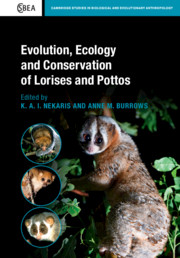Book contents
- Evolution, Ecology and Conservation of Lorises and Pottos
- Cambridge Studies in Biological and Evolutionary Anthropology
- Evolution, Ecology and Conservation of Lorises and Pottos
- Copyright page
- Dedication
- Contents
- Contributors
- Foreword
- Acknowledgements
- 1 Introduction
- Part I Evolution, Morphology and the Fossil Record
- 2 Sluggards and Drunkards?
- 3 What We Know (and Don’t Know) About the Fossil Records of Lorisids
- 4 Outliers
- 5 Molecular Advances in Lorisid Taxonomy and Phylogeny
- 6 The Toothcomb of Karanisia clarki
- 7 The Soft-Tissue Anatomy of the Highly Derived Hand of Perodicticus Relative to the More Generalised Nycticebus
- 8 Making Scents of Olfactory Sensitivity in Lorises and Pottos
- 9 Allometric and Phylogenetic Diversity in Lorisiform Orbit Orientation
- 10 The Evolution of Social Organisation in Lorisiformes
- 11 Biomechanics of Loris Locomotion
- 12 What Role Did Gum-Feeding Play in the Evolution of the Lorises?
- Part II Ecology and Captive Management
- Part III Research, Trade and Conservation
- References
- Index
6 - The Toothcomb of Karanisia clarki
Was this Species an Exudate-feeder?
from Part I - Evolution, Morphology and the Fossil Record
Published online by Cambridge University Press: 29 February 2020
- Evolution, Ecology and Conservation of Lorises and Pottos
- Cambridge Studies in Biological and Evolutionary Anthropology
- Evolution, Ecology and Conservation of Lorises and Pottos
- Copyright page
- Dedication
- Contents
- Contributors
- Foreword
- Acknowledgements
- 1 Introduction
- Part I Evolution, Morphology and the Fossil Record
- 2 Sluggards and Drunkards?
- 3 What We Know (and Don’t Know) About the Fossil Records of Lorisids
- 4 Outliers
- 5 Molecular Advances in Lorisid Taxonomy and Phylogeny
- 6 The Toothcomb of Karanisia clarki
- 7 The Soft-Tissue Anatomy of the Highly Derived Hand of Perodicticus Relative to the More Generalised Nycticebus
- 8 Making Scents of Olfactory Sensitivity in Lorises and Pottos
- 9 Allometric and Phylogenetic Diversity in Lorisiform Orbit Orientation
- 10 The Evolution of Social Organisation in Lorisiformes
- 11 Biomechanics of Loris Locomotion
- 12 What Role Did Gum-Feeding Play in the Evolution of the Lorises?
- Part II Ecology and Captive Management
- Part III Research, Trade and Conservation
- References
- Index
Summary
Toothcombs have evolved independently in various mammalian lineages, including primates, scandentians and dermopterans, but the presence of a six-toothed toothcomb composed of four lower incisors and two canines (I1, I2 and C1, bilaterally) is a distinctive feature of extant strepsirrhine primates (Yamashita, 2017). There is some variation within the group with respect to the nature of the anterior teeth: indriids have a reduced toothcomb as a result of losing the lower canines (Gingerich, 1977), whereas Daubentonia has only one enlarged, ever-growing incisor, and no canines, in each quadrant (Quinn and Wilson, 2004). Nonetheless, it seems clear that a six-toothed toothcomb is primitive for Strepsirrhini (Hill, 1953b; Martin, 1990; Szalay and Delson, 1979). The earliest fossil strepsirrhine that indisputably possesses a toothcomb is Karanisia clarki (Seiffert et al., 2003), therefore the appearance of this trait can be established by as late as 36.9 million years ago (Mya). Molecular dates for the divergence of crown Strepsirrhini are generally much earlier than this (49.8–77.0 Mya; Pozzi et al., 2014b; Yang and Yoder, 2003, and sources cited therein). If the toothcomb was present in the common ancestor of the group, it could therefore be expected to have appeared much earlier than its first record in K. clarki. However, the fossil record for crown strepsirrhines remains very limited, which means that K. clarki provides the first window into the adaptive context in which the toothcomb evolved.
- Type
- Chapter
- Information
- Publisher: Cambridge University PressPrint publication year: 2020



